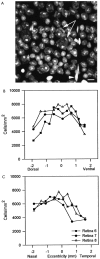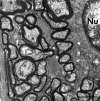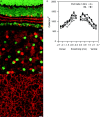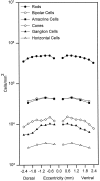The major cell populations of the mouse retina
- PMID: 9786999
- PMCID: PMC6793518
- DOI: 10.1523/JNEUROSCI.18-21-08936.1998
The major cell populations of the mouse retina
Abstract
We report a quantitative analysis of the major populations of cells present in the retina of the C57 mouse. Rod and cone photoreceptors were counted using differential interference contrast microscopy in retinal whole mounts. Horizontal, bipolar, amacrine, and Müller cells were identified in serial section electron micrographs assembled into serial montages. Ganglion cells and displaced amacrine cells were counted by subtracting the number of axons in the optic nerve, learned from electron microscopy, from the total neurons of the ganglion cell layer. The results provide a base of reference for future work on genetically altered animals and put into perspective certain recent studies. Comparable data are now available for the retinas of the rabbit and the monkey. With the exception of the monkey fovea, the inner nuclear layers of the three species contain populations of cells that are, overall, quite similar. This contradicts the previous belief that the retinas of lower mammals are "amacrine-dominated", and therefore more complex, than those of higher mammals.
Figures








References
-
- Altman DG. Practical statistics for medical research. Chapman and Hall; New York: 1991.
-
- Bevington PR, Robinson DK. Data reduction and error analysis for the physical science, 2nd Ed, pp 38–52. McGraw-Hill; New York: 1992.
-
- Blanks JC, Johnson LV. Specific binding of peanut lectin to a class of retinal photoreceptor cells. Invest Ophthalmol Vis Sci. 1984;25:546–557. - PubMed
-
- Carter-Dawson LD, LaVail MM. Rods and cones in the mouse retina. J Comp Neurol. 1979;188:245–262. - PubMed
Publication types
MeSH terms
LinkOut - more resources
Full Text Sources
Other Literature Sources
Molecular Biology Databases
